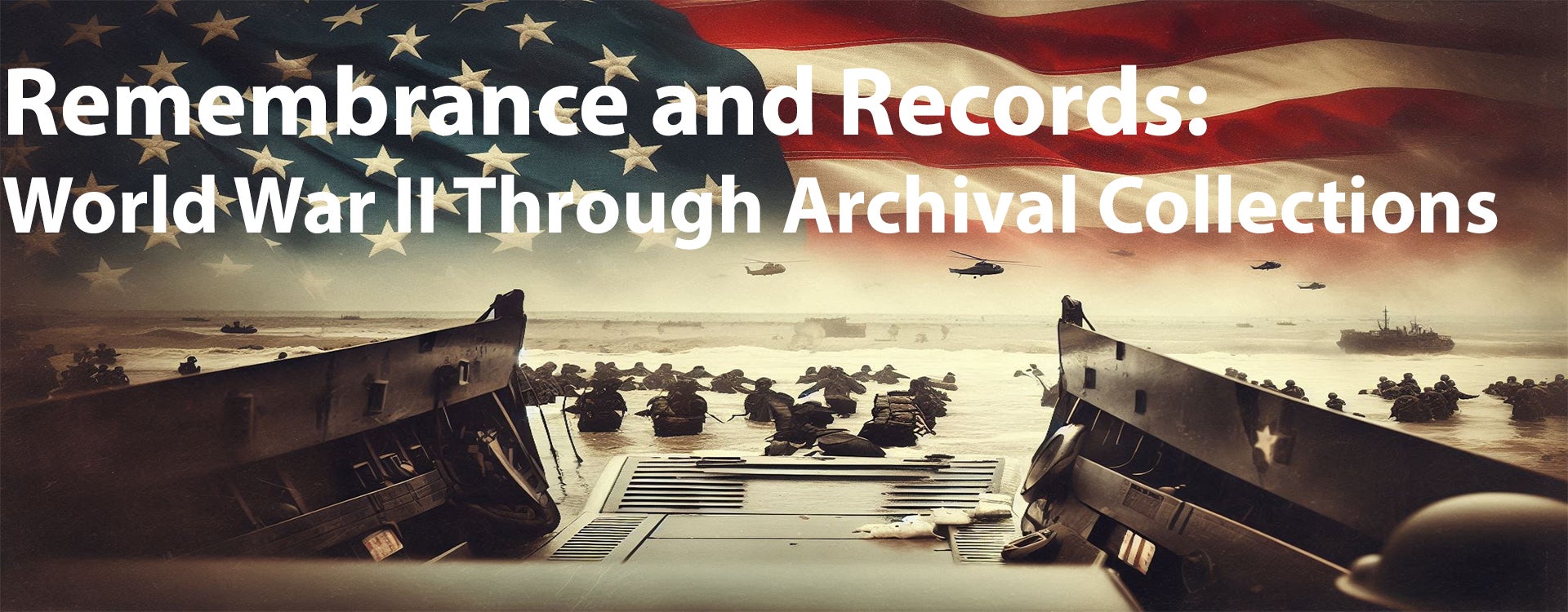Turning the Tide: The Battle of Leyte Gulf and the USS Portland’s Heroic Role
Remembrance and Records: World War II Through Archival Collections
Over the next year, in commemoration of the 80th anniversary of the end of World War II, Joyner Library Special Collections will be highlighting items from the East Carolina Manuscripts Collection that relate to the conflict and the individuals who served.
The Battle of Leyte Gulf
The Battle of Leyte Gulf, fought from October 23-26, 1944, was a pivotal World War II naval engagement between the U.S. and Japan. It marked the last major clash between the U.S. Navy and the Imperial Japanese Navy and is the largest naval battle in history. Taking place near the Philippine islands of Leyte, Samar, and Luzon, the battle was part of General Douglas MacArthur’s plan to retake the Philippines. Its outcome severely crippled Japan’s naval capabilities, securing Allied control of the Pacific.
Japan’s strategy involved dividing and destroying the Allied fleet with multiple naval forces, but superior Allied intelligence allowed them to counter this. The battle unfolded in four main engagements: the Battle of the Sibuyan Sea, Surigao Strait, Cape Engaño, and Samar. Each encounter weakened the Japanese Navy, rendering it ineffective for the remainder of the war.

The USS Portland’s war diary entry describes the vessel’s involvement in the Battle of Surigao Strait at Leyte Gulf. U.S. Navy Memorial Foundation Collection: Carl Hicks Papers (#677-037), East Carolina Manuscript Collection, J. Y. Joyner Library, East Carolina University, Greenville, North Carolina, USA.
The USS Portland (CA-33) and The Battle of Surigao Strait
The USS Portland (CA-33), commissioned in 1933, had already seen action in key battles like Coral Sea and Guadalcanal by the time it joined Task Force 34 in the Leyte Gulf. Under the command of Admiral William Halsey, Task Force 34 was tasked with protecting the Allied landings on Leyte and preventing Japanese reinforcements from reaching the island.
The USS Portland’s most significant role came in the Battle of Surigao Strait on October 24-25, 1944. Despite heavy enemy fire, the USS Portland helped inflict severe damage on the Japanese fleet and protected Allied forces. One of the battle’s defining moments occurred when Japanese Admiral Kurita’s Center Force attempted a surprise attack but was repelled by Allied gunfire, including from the USS Portland. This victory was crucial in eliminating a major Japanese threat to the planned Allied invasion. Surigao Strait would also be the last time in history that battleships would engage one another in a line of battle.
A history of the USS Portland and its participation in the Battle of Surigao Strait can be found in the U.S. Navy Memorial Foundation Collection: Carl Hicks Papers (Manuscript Collection #677-037). The USS Portland’s “War Diary” documents the vessel’s participation in key operations from 1941-1945, including the Coral Sea (May 1942), Midway (June 1942), Guadalcanal (August & November 1942), Santa Cruz Islands (October 1942), Gilbert Islands (November 1943), Marshall Islands (December 1943-March 1944), Carolina Islands (March-September 1944), Leyte (October-November 1944), Luzon (December 1944-February 1945), and Okinawa (March-April 1945). It highlights battle damage at Guadalcanal, including a jammed turret that caused the ship to steam in circles. Additional entries document kamikaze raids and submarine attacks as well as the Japanese surrender at Truk on September 2, 1945.
Aftermath
The Battle of Leyte Gulf was a decisive victory for the Allies, with Japan suffering heavy losses in ships and aircraft, ensuring that they could no longer effectively conduct large-scale naval operations against the Allies. The USS Portland played a significant role in the Battle of Surigao Strait, permitting the Allies to claim victory and eventually retake the Philippines. Following Leyte Gulf, the USS Portland continued to serve with distinction, participating in the invasions of Iwo Jima and Okinawa, before being present at Japan’s formal surrender in Tokyo Bay on September 2, 1945.
Visit the Ship’s Log, as well as Joyner Library’s social media channels, to learn more about materials related to World War II that are a part of the East Carolina Manuscripts Collection’s holdings. Joyner Library Special Collections will be displaying an exhibit of items and individual stories related to World War II during the summer and fall of 2025
Sources:
- “The Battle of Leyte Gulf.” 2020. Naval History and Heritage Command. February 27, 2020. https://www.history.navy.mil/browse-by-topic/wars-conflicts-and-operations/world-war-ii/1944/battle-of-leyte-gulf.html.
- U.S. Navy Memorial Foundation Collection: Carl Hicks Papers (#677-037), East Carolina Manuscript Collection, J. Y. Joyner Library, East Carolina University, Greenville, North Carolina, USA.
-
Vergun , David. 2019. “WWII Battle Helped Secure Philippines 75 Years Ago.” U.S. Department of Defense. October 23, 2019. https://www.defense.gov/News/Feature-Stories/story/Article/1996596/.
